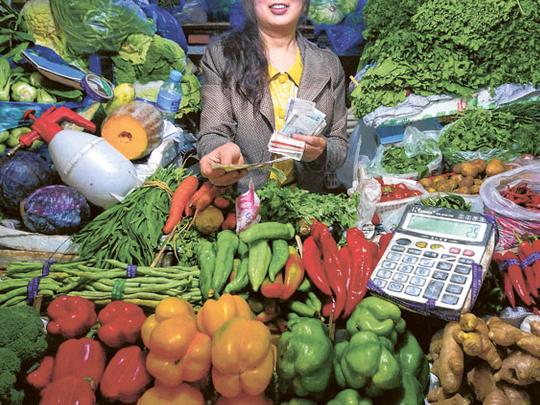
New York: World food prices rose in June as the cost of sugar, meat and dairy increased, adding to inflationary pressure that has prompted central banks across the world to raise interest rates.
An index of 55 food commodities rose to 233.8 points from 231.4 points in May, the United Nations Food and Agriculture Organisation said in a report on its website yesterday. The gauge climbed to an all-time high of 237.7 in February.
Food will remain costly in the next few years and price swings will be around "for a long time," Jose Graziano da Silva, the FAO's director-general elect, said June 27. The European Central Bank was expected to raise rates late last night for the second time this year and China did so for the third time on Wednesday in a bid to control inflation partly blamed on food costs.
"We're not yet seeing any break," Abdolreza Abbassian, a senior economist at the FAO, said via phone from Rome Thursday. "Almost in every country, including in Europe, the issue of higher food prices has already become tangible."
The price of staple foods including corn will more than double in two decades without action, Oxfam International said in May. World food output will have to rise 70 per cent by 2050 as the global population climbs to 9.2 billion from an estimated 6.9 billion in 2010, the FAO estimates.
Agricultural output
Growth in agricultural output will slow to 1.7 per cent a year through 2020, compared with 2.6 per cent in the previous decade, FAO and the Paris-based Organisation for Economic Cooperation and Development said in a report last month.
"The question of how to satisfy the food needs of an expanding population with ever more sophisticated tastes and an increasingly unified mode of consumption is getting even more pressing," analysts Veronique Riches-Flores and Loic de Galzain at Societe Generale wrote in a report on Wednesday.
The FAO sugar index jumped 15 per cent to 357.7 points, as production in Brazil, the world's largest producer of the sweetener, is forecast to fall below last year's level, the FAO said.
That lifted the entire food index, Abbassian said. Raw sugar futures jumped 14 per cent in New York last month.
"The surprise was sugar," Abbassian said. "If it wasn't for sugar we would certainly see a decline."
Policymakers in Eur-ope are concerned that surging energy and commodity costs will spark a wage-price spiral, further entrenching inflation. The inflation rate in the 17-nation euro region was 2.7 per cent in June, exceeding the ECB's two per cent ceiling for a seventh straight month.
ECB meeting
The ECB will raise the benchmark by 25 basis points to 1.5 per cent, when council members meet in Frankfurt late last night, according to all 55 economist forecasts in a Bloomberg News survey. The central bank may increase borrowing costs further in the fourth quarter, according to a separate survey.
The FAO's dairy index rose to 231.6 points from 231.1 points, lifted by rising prices for skimmed-milk powder, while the gauge for meat prices advanced to 180.4 points from 180, matching the April record level. Poultry-meat prices rose 3 per cent to a record, according to the FAO.
"High feed prices are making their way into those sectors," Abbassian said. "Given the lag, one shouldn't expect meat and dairy prices to come down just because the corn price came down last week."
US spot prices for milk rose 16 per cent in June, according to the US Department of Agriculture.
Cereals index
The FAO cereals index fell for a second month to 258.5 points from 261.3 points in May. The index is still 71 per cent above its year-earlier level.
"There has been some softening of prices, but with the big harvests coming in the Northern Hemisphere, this is the seasonal low," Abbassian said.
"And the seasonal low of this year is pretty high already, we're well above last year."
The FAO's index of cereal prices fell to 151.2 points in June 2010, the lowest level for the year.












